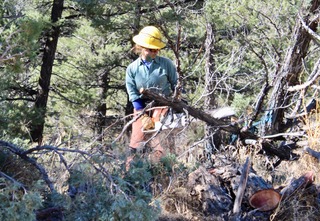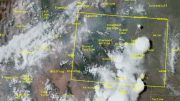Dozens of landowners in the foothills of Methodist Mountain have agreed to forest treatments that are necessary to create a community fuel break designed to protect Salida and Poncha Springs from a wildfire.
J.T. Shaver, a forester with the Colorado State Forest Service (CSFS), said treatments on private property in the fuel break will be complete by this coming spring.
Work started in February on the Hutchinson Ranch and continued on large tracts of nearby land that included town of Poncha Springs and City of Salida property. Nearly all of the homeowners who were asked in The Canyons and Piñon Ridge Estates subdivisions have agreed to thinning that will contribute to the fuel break, Shaver said.
“It is important to keep a fuel break linear across the landscape for it to be truly effective,” Shaver said. “Connectivity is key and we are achieving that.”
CSFS worked with the Bureau of Land Management (BLM) to extend treatments from private to public lands along the foothills of the mountain, especially in the County Road 110 area.
“It is a really cool thing that we’re treating cross-boundary with connectivity right from private to federal lands. It is a good collaboration working with the BLM,” Shaver said.
Forest treatments on the Methodist Front are top priority in the Community Wildfire Protection Plan, which identifies where to treat lands for the highest cost efficiency and community benefit. Treatments include hand thinning and mastication — a patch-clearing method used in the piñon-juniper forest.
Chaffee County faces the threat of high wildfire danger due to decades of fire suppression, drought and ensuing insect infestations that caused forests to decline into poor health. More frequent fires include the 2019 Decker Fire on the eastern side of Methodist Mountain that burned for five weeks and caused thousands of evacuations.
As wildfires are more intense and difficult to contain, the risk is a top community concern identified by Envision Chaffee County, which facilitated the wildfire plan update in 2020 under the Forest Health Council. Methodist Front was the first project to be designed and funded through collaborative efforts of the council’s 35 members.
On the Methodist Front, the U.S. Forest Service completed tree thinning work this year near Ohaver Lake, Silver and Poncha creeks and the Shirley Recreation Site in an area known as the Poncha Loop. The work reduces forest fuels and protects major power lines that transfer electricity to the San Luis Valley. The agency also employed a seasonal crew to work on the fuel break on Cleveland Mountain, where trees will continue to be thinned in 2022.
Altogether, Methodist Front encompasses an 8,200-acre area and significantly addresses the Forest Health Council’s goal of treating 30,000 acres by 2030 to reduce the threat of wildfire to important community assets such as water supply, infrastructure, wildlife habitat and recreation assets like the Arkansas River.
“It is critical for these treatments to be completed at a landscape scale to maximize the benefits against forest wildfires,” said U.S. Forest Service Salida District Ranger Perry Edwards. “Many of these treatments also benefit the trees of the forest and wildlife that use the habitat, so it is not a zero-sum game. Many things can benefit.”
Edwards emphasized the need to continue forest treatments to help mitigate future wildfires when they occur. “We need to continue to ramp up the acres of treatment to get ahead of areas of potential catastrophic forest fires,” he said, adding that the Salida Ranger District plans to increase controlled burning when conditions allow, to cover much larger areas for protection. He noted community concern about smoke during the Shavano Mountain prescribed burns this fall.
“Where there is fire, there is smoke. Smoke is a natural byproduct of fire and some amounts are unavoidable,” he said. “However, fire managers and prescribed fire specialists look carefully at the proximity of communities and determine the least amount of smoke impact to the public during prescribed burning.”
Edwards, who began in his position in October after former District Ranger Jim Pitts was promoted, said he believes it is much more beneficial to conduct prescription burns in the fall, when conditions are right for control, rather than fight wildfires in the summer “when conditions are not good for control.”
All treatments by the CSFS on Methodist Mountain’s private property are done by hand or machine. The Forest Service plans low-intensity broadcast burning to complete treatments on public lands in years to come.
The Methodist Front project is funded by the National Fish and Wildlife Foundation’s RESTORE Colorado grant program, with matching funds from the U.S. Forest Service, the municipalities of Salida and Poncha Springs, Great Outdoors Colorado (GOCO) and Chaffee Common Ground.
The Forest Health Council has raised $12 million in less than two years for projects such as Methodist Front and programs like Chaffee Chips, a slash service that has helped Methodist-area and other property owners remove 1,000 piles of slash since 2020.
For more information about the Forest Health Council’s wildfire protection projects and programs, visit envisionchaffeecounty.org/ensuring-healthy-landscapes.
- Susan Marie McFee - April 19, 2024
- US 50 bridge closed west of Gunnison due to safety concerns - April 19, 2024
- Friday, April 19th Weather - April 19, 2024




